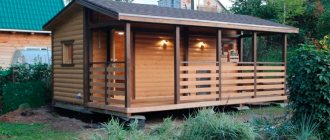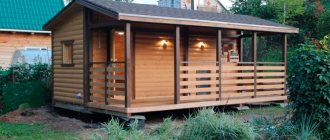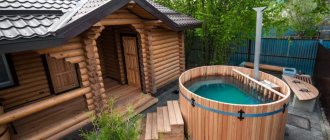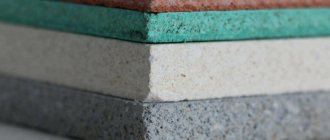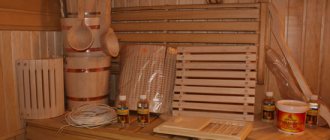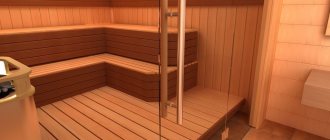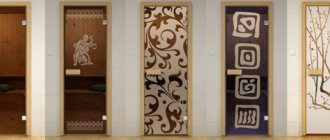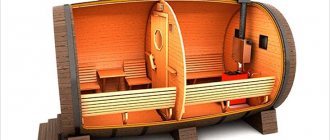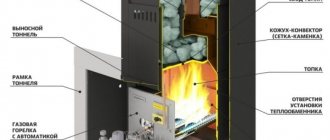A bathhouse on a personal plot or dacha is the dream of many owners. Such water procedures are not only pleasant, but also useful - they cleanse and strengthen the body, and help improve blood circulation. Friendly communication over a cup of aromatic tea after a steam room can hardly be overestimated. When it comes to choosing a material for building a bathhouse, you need to take into account not only the price factor. This is a specific room with special functions, high humidity and temperature. Therefore, it is important not to get lost among the diversity that the market offers. To choose what to build a bathhouse from, it is recommended to consider different building materials in advance from the point of view of their suitability for the construction of a given building. This will allow you to understand which one will be optimal for your needs and conditions.
Frame
Frame-panel structures became popular among consumers several years ago. They are quite easy to assemble and do not require a large amount of natural wood or special equipment.
An inexpensive frame bathhouse is placed on a lightweight foundation, most often a columnar one is chosen. This significantly reduces construction costs since it does not require as much concrete to pour the foundation.
The walls of the bathhouse are most often mounted from ready-made frames, which are immediately manufactured in the workshop. If desired, to further reduce costs, you can assemble the frame yourself, but this will slow down construction. To create good thermal insulation and for a long service life of the building, it should be sheathed with suitable boards. To save money, coniferous species are suitable.
Attention! For frame baths, timber and logs are often used. But these materials are very expensive, although they are of excellent quality and long service life. Unplaned timber will allow you to save as much as possible on material. It is not as beautiful, but very affordable.
Since frame baths have thin walls, they require mandatory insulation. Among inexpensive insulation materials, mineral wool is most often chosen. It is laid in the walls in the form of slabs. They are not only affordable, but are also reliable and have a long service life, provided they are installed well.
Attention! When building frame-panel baths, you cannot skimp on protecting the frame and vapor barrier. If you have very little money, then give your preference to polymer film and aluminum foil. They are quite hopeful and belong to the economy segment.
tip #8: Why do you need a bathhouse attendant?
If you don’t know how to steam properly and don’t want to learn the wisdom of bathing on your own, use the services of a professional bathhouse attendant. He will not only prepare a comfortable bathhouse for you, but will also choose the appropriate broom, because this is a whole science!
And then it will steam your body properly: it will relax or, conversely, tone your muscles. It all depends on your preparation and attitude.
The work of a broom master and a gang costs about 1000 rubles for one steam bath, depending on the class of the bath and the duration of the session. Connoisseurs usually do not limit themselves to one soaring session and lie down under the broom several times.
From cinder blocks
Such baths began to be built not so long ago. They are very affordable, easy to build and last longer than wooden ones. Such structures require good insulation and mandatory vapor barrier. It is especially important to approach this issue if your latitude experiences constant temperature changes and cold winters.
Cinder block does not require additional protection against mold or mildew, which allows you to save on treating walls with an antiseptic. Also, cinder blocks do not burn, which eliminates the need to use fire retardants. There are several types of cinder blocks.
Expert opinion
Lovkachev Boris Petrovich
Bath master who knows everything about steaming
Attention! Cinder blocks can have different compositions; you should definitely familiarize yourself with them before purchasing. The best composition is shell rock, sand, expanded clay, sawdust and crushed stone, which are fixed with cement.
For supporting structures, it is advisable to choose monolithic blocks. They are strong and will enhance the load-bearing properties of the walls. For external walls, it is recommended to choose blocks with voids occupying 30% of the block volume. Internal partitions are erected from small blocks weighing 10-13 kg with a minimum thickness. This is necessary to save space indoors.
In addition, the internal walls rarely act as load-bearing walls, which eliminates the need for their significant strengthening. The same materials can be used as insulation and vapor barrier as for a frame bath.
To build baths from cinder blocks, you also do not need an expensive foundation, which allows you to save up to 50% of the budget. Usually a columnar or strip base is chosen.
The main thing is that it is perfectly aligned horizontally to avoid movement and deformation of the walls. If you violate the foundation laying technology, large cracks will appear on the cinder blocks.
Attention! Cinder block baths are not suitable for everyone. They are characterized by increased sound permeability. To eliminate this drawback, additional sound insulation will be required. It is worth calculating what is more profitable in this case: to build a bathhouse of a different type or to build a structure made of cinder blocks.
Which one is warmer?
A properly insulated frame bathhouse warms up well. Panels laminated with foil on one side retain heat well. The doors to the steam room need to be vapor-proofed, and the front door also needs to be waterproofed. The greatest attention is paid to the insulation of the steam room.
However, the frame cannot accumulate heat; it is not heat-intensive, unlike timber. If you stop heating such a bathhouse, the room will quickly cool down. On the other hand, due to the same heat capacity, it will take more time and fuel to warm up the frozen timber.
Important!
During the cold season, the performance characteristics of baths are significantly reduced: the room cools very quickly.
Good quality timber is able to maintain high indoor temperatures for a long time. If its quality does not meet the standards, cracks and crevices will gradually appear inside, through which cold air will enter the room. The defect can be eliminated by re-caulking.
Windows can be installed to ventilate the room. The main thing is that they are small and not located too high from the floor, so that warm air does not escape through them.
Foam block
This material also began to be in demand for the construction of baths not so long ago, but has already earned its respect among consumers. Foam block structures are lightweight and do not require the construction of a serious foundation.
Despite the fact that foam blocks retain heat well, you should definitely take care of good thermal insulation. It is especially important to think about it in case of severe winters. Foam block baths are not afraid of fire, which allows you to save on fire retardants, while the material does not crumble even at very high temperatures.
The strengths of foam block baths are their rapid erection, naturalness of the material and ease of cladding. The environmental friendliness of the materials eliminates the release of toxins and harmful substances when heated. And the low cost makes it possible to compete with other materials, gradually displacing even wood.
Attention! When using wooden slats or any wood elements as cladding for foam blocks, they should still be carefully processed for fire safety and protection from rotting.
tip #3: What to take with you to the bathhouse?
You should prepare for a sauna trip seriously, in advance and thoroughly. The main thing is not to forget anything that may be useful for a comfortable stay. Therefore, we suggest using our universal list of necessary things for a sauna.
Water or herbal/green tea
In the bath, the body loses a lot of fluid, so it is important to quickly restore it. Green tea or a herbal drink after a bath will help remove toxins as much as possible and unite all steam lovers over tea.
cap
This is the best protection for your head from overheating. Before visiting the steam room, we recommend that you wet your cap.
Broom
A broom can be used for massage, inhalation and increase the metabolic rate. Most often it comes in handy for experienced steamers in a Russian bath. The most popular bath brooms are made from birch.
Hard washcloth
A washcloth can easily help cleanse your skin of dead skin cells. Its fibrous structure affects the body both externally and internally: it returns elasticity and smoothness to the skin, improves blood circulation and massages. Experienced bath attendants recommend washcloths made from luffa and bast.
Bath soap
Bath soap can be used not only to wash the body, but also the head. It must be natural, without chemical compounds. In a hot steam room, artificial substances can become toxic.
Robe
Just keep in mind: the sauna does not tolerate synthetics. The ideal bathrobe should be made from 100% natural fabric.
Two towels
One is for drying off, we recommend using the second as a bedding in the steam room. Terry and bamboo towels absorb moisture most effectively.
Cosmetics
After the bath, it's time for the spa. Your skin will be more ready than ever for masks and scrubs that can be used in abundance.
From aerated concrete
In its characteristics, this material is similar to foam blocks. Aerated concrete blocks are made from a mixture of cement, sand, aluminum mixture and special gas-forming substances. During a chemical reaction, the mixture hardens, and pouring into special molds allows the block to be given the correct shape.
Aerated concrete baths are prefabricated, lightweight, and do not require the construction of a solid foundation. In terms of ease of processing, the material is comparable to wood; it is easy to cut and assemble.
In terms of thermal insulation properties, aerated concrete blocks are not inferior to timber, which allows you to build a very warm and strong bathhouse. The special composition of the material allows you to avoid the appearance of mold and mildew, but you should understand that this requires proper ventilation.
The blocks do not burn, and when exposed to high temperatures they do not emit any harmful substances or toxins.
The only drawback of aerated concrete is its high ability to absorb water. This is due to the porous structure of the material. To prevent a reduction in the service life of the bathhouse and destruction of the concrete structure, good waterproofing is required. Particular attention should be paid to this work in the steam room and washing room. The floor in such baths should always be left wet and not insulated with anything.
Attention! Aerated concrete does not shrink significantly; it does not exceed 1-2%. This moment allows you to immediately begin decorating the steam room and dressing room.
What material to choose to build a bathhouse (reviews)
Nothing helps you make a choice more than reviews from people who have experienced something themselves.
Before building my own bathhouse, I thought that it had to be made of wood, but wood breathes.
But no matter how much I walked around such baths, no matter how long I stayed inside, I never saw (didn’t feel) this breath. Today I am sure that a bath is the conditions that should be created in a steam room, the optimal ratio of humidity and temperature. The project was born quickly, because I clearly understood what I wanted from it: a steam room and a wash room must be separate, a large and comfortable relaxation room, a firebox must have a fireplace effect and... the opportunity to spend time comfortably in the winter. A bathhouse in winter is a song. That’s why I chose foam blocks for the walls. Konstantin
https://www.forumhouse.ru/threads/394720/
My steam room/sink is a log house made of aspen d=250\300 and the dressing room is a frame building.
I did not pour concrete under the pouring floors, but welded a frame of 12 reinforcement bars with slopes in the center towards the scupper (aka ladder) and stretched a thick plastic film. I also made “eternal” joists under the floors, fortunately we sell inexpensively used thick-walled timber (76\6 mm), welded strip pads to it along the edges (so as not to spin) and scattered 6 pieces. with an interval of 0.5 m (the ends of the pipes lay on the lower strapping beam, in the places where half-logs are placed near the log house). Another “know-how” is to ensure that the floorboards of the pouring floors are not attached to the joists (you can always lift them to dry, or clean the drain under them) and so that they do not run together and lie at equal intervals. Along the edges of the boards (with an indentation of 10 cm) you drilled and inserted PVC “mushrooms” to attach the insulation to the facades, then you measure 10 mm and cut the mushroom with a hacksaw. The result is a board with spaced chips along the edges, simple and reliable, it won’t rot and holds tightly. Andrey
https://www.forumhouse.ru/threads/282522/page-2
In fact, from a quality point of view, frame 100 or timber 100, raw, unplaned, and frame 200 are the optimal technologies, respectively, for an unheated and heated bathhouse.
Viant
https://www.forumhouse.ru/threads/389121/
Good afternoon
The wood concrete material for a bathhouse is not bad, but you need to use it wisely. Namely, it is possible to insulate if the wood concrete is not plastered, it breathes wonderfully, the cake will turn out like this: internal lining (solid wood) ventilation gap 1.5–2 cm, vapor barrier, basalt insulation 5–10 cm, wood concrete, windproof film, ventilation gap 2–5 cm, outer skin. Why is basalt insulation used? Because the thermal conductivity of the insulation is much lower than that of wood concrete, therefore there are fewer losses and faster warming up. If you plaster the outside, then such a structure will not be able to breathe towards the street and will accumulate moisture, and it can even penetrate through the vapor barrier, since small leaks and damage are possible. In terms of vapor permeability, materials must follow each other in order of increasing vapor permeability (from the inside to the outside); there are no plasters comparable in vapor permeability to wood concrete. Tooth
https://www.forumhouse.ru/threads/100295/
Regarding the construction of a bathhouse from laminated timber.
A definite plus, from my point of view, is minimal shrinkage and understandable behavior of the timber in the future. Of course, provided that the timber is of high quality. Konstantin
https://www.forumhouse.ru/threads/390466/
Inexpensive mini-baths
Such designs are usually chosen for small areas or with a very limited budget. Mini-baths can be of several types, but they all include a dressing room and a steam room. A washroom or shower room is found only in the largest structures of this type, and in this case it is always combined with a steam room.
Mini-baths are usually built from boards, logs or timber. They can be built on a wooden frame or mounted on wheels for mobility of the structure. The most popular models of inexpensive mini-baths are barrels. They are convenient, attractive in appearance, and can be installed on a foundation, without it, or on rolling stock.
It is recommended to build mini-baths only in cases of limited space. In terms of cost, due to the peculiarities of size and design, such baths will be equal in cost to frame-tile type structures or those built from cinder blocks.
tip #2: When to go to the bathhouse?
It is more profitable to visit bath complexes in the summer, since prices during this period are much lower. You will also avoid difficulties with booking due to the low demand for sauna services.
To save money, we recommend choosing weekdays for your bath. Compared to weekends, the cost will be 20-30% lower.
Also, the cost may vary depending on the number of people. According to our statistics, the best price for renting a sauna is set for small companies of up to 5-6 people.
It is more profitable to visit the baths in the summer
On weekdays the cost is 20-30% lower
The price for companies up to 5-6 people is lower
Save your budget
If you have a small budget, you can save on several points. Such savings will not affect the quality of construction, ensuring the construction of a reliable structure.
You should not buy a stove with a remote firebox. Such a purchase will not only be cheaper, but will also allow you to heat up the steam room much faster, and this will save firewood.
If the soil allows, give preference to a removable foundation. It is very inexpensive, allows you to quickly carry out the necessary repairs if necessary, and is easily dismantled and replaced with another.
If you plan to have a window in the bathhouse, be sure to insulate it in the winter; regular film with bubbles, which is used for packaging, is suitable for these purposes. It is used to trim the frame from the outside.
There is no need to install a shower stall or install a shower in the washroom. Just put basins or tubs for water. It is not so convenient, but very economical.
To reduce the cost of the roof, you should not make it very high. This will not only reduce the cost of cladding, but will also make the chimney not so high.
Attention! In a budget bathhouse, you will also need to abandon full sewerage and water supply. For cold water, you can put barrels or equip a hose. Water in such baths is usually simply poured onto the floor, from where it is immediately absorbed into the ground.
tip #6: How long can you spend in the sauna?
For newcomers to the bathhouse, they recommend no more than three visits to the steam room. Rest time between visits is at least 10 minutes.
optimal time in the bath
| Newbie | Master | |
| First run | 8 min | 10 min |
| Rest | 20 minutes | 15 minutes |
| Second run | 10 min | 12 min |
| Rest | 12 min | 20 minutes |
| Third run | 12 min | 15 minutes |
What you can't save on
Even if the budget is very limited, it is strictly forbidden to save on the following points:
- Use of construction products without a quality certificate . Such building materials are several times cheaper, but there is no guarantee that they will not emit harmful fumes during use, especially when exposed to high temperatures. In addition, such materials can quickly fall apart and become completely unsuitable for further use.
- Saving on electrical wiring and related elements . You should not buy the cheapest sockets, hang uninsulated lamps and unsuitable wires. Such things will not only quickly fail, but they also increase the risk of fire and accidental electric shock several times.
- Use of unsuitable materials . If you want to save money, you should not replace recommended products with those that cost an order of magnitude cheaper, but at the same time, due to their performance characteristics, cannot be used in a bathhouse. This applies to insulation, flooring, and some types of wood. Unsuitable materials for specific conditions will not fully perform their task and will quickly deform or rot.
- Sauna stove and water heater . You should not buy handicraft products. They are not always safe; they may not be tightly sealed enough, which can cause a fire or burn.
Attention! Also, do not skimp on fuel for your sauna stove. Do not throw flammable materials into it that are not intended for use in enclosed spaces with high humidity and temperature. They can saturate the air with harmful substances, which will cause poisoning and even death.
tip #5: What to do in the bathhouse?
Preparation before the bath
- Take a warm shower
- Put on a bath cap
First entry into the steam room
- Sit on the lowest bench and get used to the hot air
- After 3-4 minutes you can rise higher and lie down, placing a cushion under your feet
Do not hang your legs off the bench under any circumstances. The temperature of the feet should not be lower than the temperature of the head.
Rest
- Take a swim in the pool. If it's very hot, take a dip in the plunge pool or douse yourself from an ice tub
Second entry into the steam room
- Take a woolen mitten (washcloth) to the bathhouse, blot the sweat with it and cleanse the skin
- Sit on the highest shelf if you feel good
Rest
- Take a swim in the pool
- Take a warm or hot shower using a washcloth, soap and scrub
- Drink a glass of water or a cup of warm tea in small sips
Tips and tricks
Regardless of whether you are building an expensive or cheap bathhouse, you can use a number of effective tips:
- Choose the right bathhouse design, taking into account how many people are going to use it. The best option is 10-15 sq.m. Such dimensions allow you to equip all the necessary rooms and not spend a lot of fuel on heating.
- All boards and wooden bases must be treated against pests, mold and fungi. If this is not done, the bathhouse will last only a few seasons and will quickly require repairs.
- The ceiling is not made very high. Measure how much height you need to sit freely on the shelf and add 15-20 cm from above so as not to touch the ceiling with your head while floating.
- Doors should be installed with a high threshold. This speeds up the heating of the room and prevents the heat from quickly leaving the steam room. Be sure to seal the door to minimize heat loss.
- If possible, try to make the outer wall at least 30-35 cm thick. This will keep the heat in the steam room for a long time, which is especially important in winter, when the bathhouse cools down much faster.
- Windows are more than just decoration. They are recommended to be used as an additional fire exit. They should be placed on the western side, where there is the most sun in the afternoon, when the bathhouse is mainly heated.
Attention! Be sure to protect the bathhouse from drafts. To do this, you will need not only to properly insulate the seams, but also to correctly mark the doors. To prevent drafts inside, they should not be placed perpendicular to each other.
Building dimensions
What size bathhouse is best to choose for construction? Let's start with the height of the ceilings. To make it comfortable to move around in the room, even if your family members are of average height, you should not make the walls lower than 2.1 m. After all, it is necessary to take into account that the shelves in the steam room are made at a level of 1 m from the floor. A person should sit on it without bending over. Plus, you need to leave free space under the ceiling for the sweep of the broom. You should not make the ceiling higher - it will take longer to heat the room.
Now let's talk about the length and width of the building. As a rule, a bathhouse consists of 3 rooms: a dressing room, where you can undress and relax after the bath, the steam room itself, and a sink. According to the standard, the ratio of such premises is 2:1.5:1. That is, the dressing room is made a little larger.
Steam room dimensions
The size of the sink should be sufficient for at least a couple of people to sit comfortably on benches with basins. There is 1 sq.m. per person. m of free space. It is necessary to leave free space for containers with water. If desired, a shower room or a small pool can be made.
The dimensions of the steam room are minimal. If several people will visit the bathhouse at the same time, then each of them must be allocated 1.5 m2.
The width of the steam room depends on the size of the shelf. Some people like to steam while sitting. In this case, it is enough to build a bench 40-45 cm long. For those who like to lie in the steam room, its length is 95 cm. You can use the space rationally if you build shelves in the letter “L”. In this case, even small benches can accommodate two people. You can make a couple of shelves on opposite walls. For free passage between them, you must leave 80 cm.
The dimensions of the steam room itself depend not only on the size of the shelf, but also on the type of oven. It is also necessary to take into account the recommended distance from it to combustible structures (wall cladding). This is done for fire safety purposes.
You should also focus on the length of the logs. As a rule, it is 6 m.
Questions and answers
In the case of using boards to build a bathhouse, is it possible to use unedged material or will the quality of the structure suffer from this?
No. You can safely use unedged boards if you have no complaints about their appearance. The main thing is that the wood itself is strong and dry.
Why do you need a vapor barrier if insulation is already used to lose heat?
Insulation and vapor barrier perform different tasks. Vapor barrier prevents the destruction of wood due to constant ingress of water and exposure to high temperature.
Does the wood need to be treated again after some time has passed since it was put into use?
Necessarily. To prevent the wood from drying out, use antiseptics and fire retardants from time to time. To be on the safe side, all wood can be varnished again once a year.
What is better: an individual project or a standard building?
An individual project is much more expensive, so if you are building a budget bathhouse, you should focus on standard small-sized projects.
Where is the best place to install the door?
It makes no difference what kind of bathhouse you are building. Always install the door on the south side if you plan to use the steam room in winter. This way the snowdrifts will melt quickly and will not block the entrance.
A budget sauna is a reality that everyone can implement on their own site. Careful familiarization with the characteristics of materials for construction, as well as knowledge of where costs can be reduced, allows you to build a durable structure for relatively little money.
Operational problems
The negative aspects and difficulties of operation come down to the installation of high-quality thermal insulation and the ability of the building to retain and accumulate heat.
Important!
The main heat losses occur due to poor insulation of the floor, ceiling, cracks in window and door openings, and through improperly installed ventilation! An important factor is roof insulation.
If the construction technology was followed and all the nuances were taken into account, it does not matter what technology the construction was used.
Video
To complete the picture, you can watch the user’s opinion; this video will help you draw conclusions.
Which wood is best to build a bathhouse from?
First of all, we suggest that you familiarize yourself with the classic version of constructing a wooden bathhouse. Many, paying tribute to traditions, prefer this type of material, because ancient Russian baths were made from round logs. Some believe that it was thanks to the natural material that Russian steam rooms had their wonderful healing properties and fabulous design known throughout the world.
Another advantage of this choice is that in our area there has never been a shortage of wood, so you can easily find the type of wood you need. As a material for a bath, you can use not only round timber, but also wooden beams.
There is a decent variety of trees that can be used to build a bathhouse. We advise you to decide which type of wood you will use only after calculating the amount of work and determining the amount of money that you can spend on the construction of your structure.
A significant advantage of a wooden bathhouse is its environmental friendliness, which in our time of high technologies that affect the environment, to put it mildly, not in the best way is a rather important factor. And, of course, the microclimate inside the bathhouse will be the most pleasant.
The disadvantage of buildings made of wood is that in order to fully use it for its intended purpose, it needs to be allowed to sit for about a year and a half so that it dries and shrinks. Only after this long enough time has passed will you be able to begin decorating the interior of your creation.
It is impossible to say for sure what kind of wood to build a bathhouse from; everyone will be able to choose the option that is suitable specifically for them.
Let's see what types of wood are suitable for building a bathhouse, let's look at their pros and cons.
Pine
Pine is most often used as a material for creating baths.
There are a number of pretty good reasons for this.
- Pine is a tree that differs from other trees in its ability to grow in almost any conditions and on any soil, including clay surfaces. For this reason, it is most often found in our strip.
- In a pine forest, the bulk of trees are suitable for use in building construction. Since most pine trees have a smooth trunk without pods or cracks.
- Pine wood is very light, but at the same time durable. Easily chopped and processed. When drying it shrinks slightly. Cracks rarely appear on it.
- Being in a bathhouse made of pine logs is doubly beneficial for health. After all, the essential oils released from it have a beneficial effect on the respiratory system.
- Relatively low price.
Pine has a brown core and a golden-white top layer.
The disadvantage of this type of wood is the increased release of resin and the need to treat the log house with a lot of protective agents.
Cedar
Bathhouses made of cedar are less common than pine buildings. Cedar cannot be found in every region; it mainly grows in the Urals and Siberia; this tree species is a rare and expensive , but a bathhouse made from such a forest will make a richer impression.
By the way, the correct name for cedar is Siberian pine.
The log house of the Siberian pine can be distinguished from the log house of its less fastidious relative, the pine, by its bark. If Scots pine has a rather thick and rough skin, then cedar has a woody skin as thin as parchment paper.
This wood has a reddish-pink center and golden-pink outer layers. In addition to its beautiful color, cedar has increased resistance to rot and fungi, strength, softness and lightness - in general, all those positive qualities that pine pampers us with.
Spruce
Spruce baths are slightly less durable than their pine counterparts, for the reason that: Firstly, spruce logs shrink more, and secondly, this species is less resistant to cracking.
However, all the same, this type of material remains very popular .
Spruce is an unpretentious tree, and therefore is found quite often in any part of Russia. Due to its prevalence, choosing this type of wood to build your masterpiece will cost you the least.
By the way, some believe that spruce produces resin longer than other conifers, has an uneven, knotty trunk and low strength, but these are all myths.
A spruce log house has all the positive qualities that are inherent in other coniferous species, of course, if the logs that are selected are of good quality.
When cut, spruce is not much different in appearance from pine. It has clearly visible growth rings, dark heartwood, and light yellow sapwood.
Larch
Larch also belongs to the coniferous species, however, unlike its other relatives, it cannot be called evergreen. In winter, like all deciduous trees, it sheds its soft needles.
Globally, larch grows only in the Siberian regions, it has a thick, tall trunk, and is not so easy to cut down. Therefore, in our area, bathhouses made entirely of such wood are rare. Due to the complexity of delivery and processing , the price of such a log house is quite high.
However, if your financial resources allow you, the quality of a larch bathhouse is worth the cost.
The trunks of this species are strong, heavy and hard, and if a felled log is still soaked in water, its strength can only be compared to a stone. Another plus is that there is no need to treat larch with solutions against insects, fungi and rot; it copes well with these problems on its own.
Thanks to all these features, a larch log house will delight you, your children, grandchildren and great-grandchildren.
Aspen
In ancient Rus', only high society could afford a bathhouse made of coniferous trees. But a simple peasant had to be content with a bathhouse made of aspen logs.
Of course, aspen is not the worst choice for building a bathhouse, but in tandem with price and quality, it is still inferior to other wood species.
Aspen is good because , thanks to its satin-white color of the trunk, it easily absorbs paint, varnishes and other necessary special solutions.
The disadvantages are that it will be difficult for you to choose trunks of the desired shape and size, the wood of this tree will soon darken, and a bathhouse made of aspen is less durable than buildings, for example, made of cedar.
Oak
Oak is the king of trees used in construction. It has a noble dark shade, a beautiful cut pattern, is highly durable , and is resistant to fungi and rot.
However, due to the whimsicality and love of this tree species for fertile land, it was previously cut down with enviable consistency. After all, where the oak grew, you can safely plant and successfully grow any fruit crops. Therefore, now oak is not the most common tree.
So the price of this material is fantastically high. And even if your income allows you to invest such a sum of money in a bathhouse, we still believe that it is enough to make only a few main rows of oak from oak.
